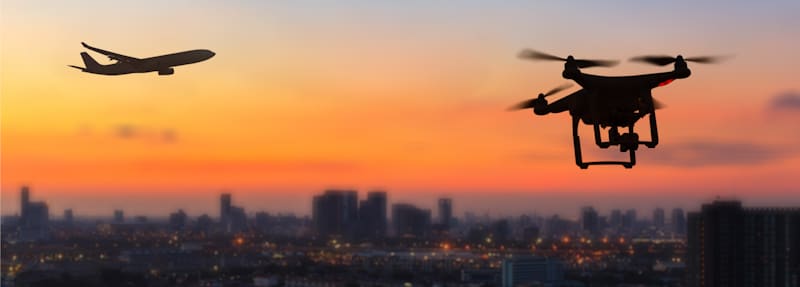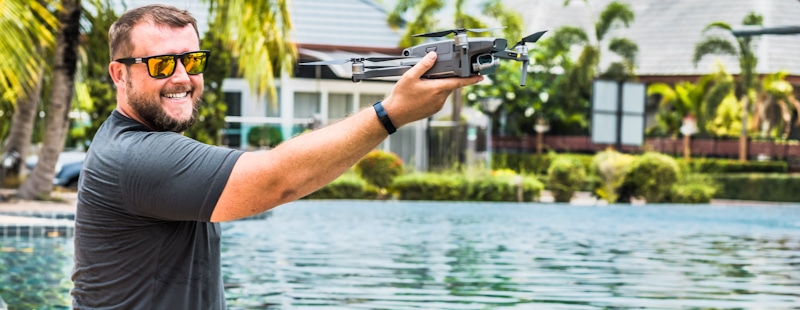Flying a drone can be a lot of fun but you want to make sure that you don't break any rules while doing so. This may leave you wondering if you're allowed to fly a drone anywhere or if there are some places where it isn't allowed.
According to the law, you can fly a drone throughout class G airspace. This is the airspace that the Federal Aviation Administration (FAA) considers uncontrolled airspace. You cannot fly your drone in no-fly zones, typically these are areas located around airports.
There are a few other no-fly zones you need to know about. Keep reading to know more about the rules and other aspects to consider when flying your drone.
Basic Rules for Flying Your Drone
When you first get a drone and want to be able to fly it, you must know some basic rules regarding where you're legally allowed to fly it. These include:
- You must maintain your drone at a height that's below the maximum allowable altitude which is typically 400 feet (121 meters) AGL (above ground level: the height from the ground to the sky). Doing so is important because it'll allow you to avoid conflicting with manned aircraft. This rule does vary depending upon what country you're in. For instance, in Canada, the maximum allowable height is 90 meters. This is why you're responsible for checking with your local aviation authority and ensuring that your drone stays within the AGL limits at all times.
- You must maintain a visual line of sight with your drone at all times. In other words, you can't rely solely upon your drone's FPV camera or a vision-assisted aide (e.g. binoculars, telescopes). This is why it's a good idea to know what your local forecast is like at all times too.
- You should never fly over people who aren't members of your flight crew. This is why you should avoid flying over stadiums, events, and festivals where you'll find large groups of people congregating.
- You must follow your community's guidelines. Many cities, towns, and provinces have their own local regulations regarding flying drones. If there aren't any such regulations you should defer to those that are laid out by your country's aviation authority (e.g. the FAA).
- You should never fly your drone after dark even if it has night lights. Dark is defined as 30 minutes before sunrise or 30 minutes after sunset (a.k.a. civil twilight).
Laws Regarding Where You Cannot Fly a Drone
Although Class G airspace is labeled as "uncontrolled," there are still places where drone flight is either restricted or prohibited. For instance, you cannot fly over a raceway during an event, a federal prison, or a military base. Some of the other places where you can't fly include:
- Airports and flight paths are considered no-fly zones unless you get a waiver or authorization to fly there. There is the Low Altitude Authorization and Notification Capability (LAANC) online system that was launched in 2018 to allow people to request permission to fly their drone within class B, C, D, and E airspace around airports. There are several free apps (e.g. Kittyhawk, AirMap) that will allow you to submit a LAANC request. Typically you will get an answer back within a few seconds.
- The area above and around the White House is considered a no-fly zone. Even if you fly within 15 miles of Washington DC you may be faced with fines or even jail time.
- Sports arenas will only allow the Goodyear Blimp and certain fighter jets to fly above their sporting events. This is done in order to protect the fans below. Remember, you can't fly over the top of people. Additionally, this is done to protect the sporting event's IP because your drone is a camera – something that isn't allowed into a paid sporting venue.
- You cannot fly over a wildlife refuge because the FAA wants you to show some respect for the animals that are living there. Unfortunately, there are a lot of places throughout the United States that are designated as wildlife refuges. According to the FAA, no aircraft is allowed to fly at under 2,000 feet AGL in these areas. Considering that your drone cannot fly more than 400 feet above the ground this means that you won't be able to fly there. Of course, there are some rare exceptions to this rule but you probably won't meet these rules.
- You won't be able to fly over forest fires or wildfires once these fires are big enough that manned aircraft are required to get involved with the fire-fighting and life-saving efforts. This is because the FAA will enact a temporary flight restriction for the area at such times. When this happens, all aircraft are banned from the area. The only drones and airplanes that will be allowed in are those that are a part of the fire-fighting operation. If you break this rule you'll be held liable for any lives that or lost or any additional acreage that is burned because your drone has prevented manned aircraft from performing their crucial work.
- Originally the FAA would allow the usage of drones within the range of a military base (including Army, Navy, Air Force, National Guard, and Coast Guard). Obviously, this wasn't encouraged though. This rule has since changed and the FAA has placed limitations on drones in these security-sensitive areas making them restricted airspace. One of the reasons for this is that you never know for sure when a low flying, high-speed military aircraft may be flying through the area.
- You can't fly your drone over the top of prisons because in the past people were using them to drop contraband off to the inmates who were being housed there. Not only was this illegal but now it's also illegal to fly your drone there.
- Department of Defense (DOD) facilities haven't allowed drones to fly over them since August 2018. This is especially true of some of those facilities that are located in St. Louis. There are a few DOD facilities that still aren't considered no-fly zones. However, you're better safe than sorry here.
Understanding Temporary Flight Restrictions (TFR)
Besides having places that are listed as no-fly zones, the FAA is also able to enact a TFR (Temporary Flight Restriction) in any area and at any time. When the FAA chooses to do this the restrictions will override any other rules that may have already been in effect for this area. In other words, all unauthorized flights in this area will be restricted for a specific period of time.
Typically a TFR is put into place to prevent unauthorized aircraft from flying over things like outdoor sporting events, military operations, emergency situations, construction sites, and other such situations. This is done because the FAA believes that this unauthorized air traffic would interfere with an important operation or that it might otherwise cause some type of undue risk to other people in the area.
U.S. Rules for Flying Drones
Even when you're flying your drone in uncontrolled airspace there are some laws and restrictions that the U.S. has put into place for both recreational and professional aircraft. While professionals can sometimes apply for a waiver of these restrictions, most drones cannot. Therefore you need to know about some of the biggest requirements which include:
- Your drone must weigh less than 0.55 pounds. Otherwise, you will be required to pay a $5 registration fee to the FAA. Once you've completed your registration online at the FAA website for an "exception for recreational flyers" your registration will be valid for three years. You'll be given a number that you must affix to the outside of your drone and a certificate that you must carry with you anytime you're flying your drone. If you choose to fly your drone for any other reason than recreational purposes you will also need this license.
- You cannot fly your drone above 400 feet from ground level.
- You can only fly your drone in daylight hours.
- You must fly your drone at speeds of at or below 100 M.P.H.
- Someone (either the drone's operator or an observer) must remain in sight of the drone at all times.
- You must heed way to and not interfere with manned aircraft and emergency response activities.
- You cannot fly over the top of other people or moving vehicles.
- You cannot operate your drone from a moving vehicle.
- You can't be under the influence of drugs or alcohol, including any legal medication that may impair your ability to safely operate your drone.

Currently, there is no test that must be taken prior to being able to fly a drone. Someday the FDA may choose to devise such a test but until that day you must simply follow these basic rules.
Conclusion
Flying a drone can be a lot of fun but you do need to be aware of the laws regarding where you can and cannot fly your drone. According to the law, you can fly your drone in a lot of great places so have fun doing so.
Shawn Manaher loves to play with new toys and dive into new hobbies. As a serial entrepreneur, work definitely comes first but there is always room for hobbies.



